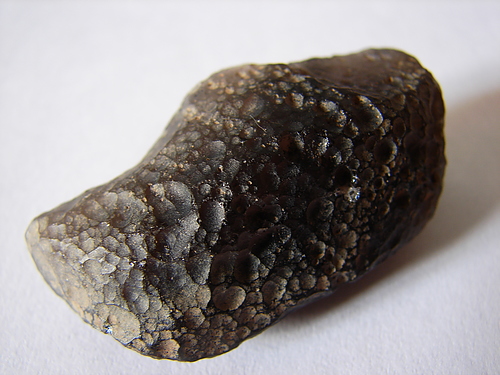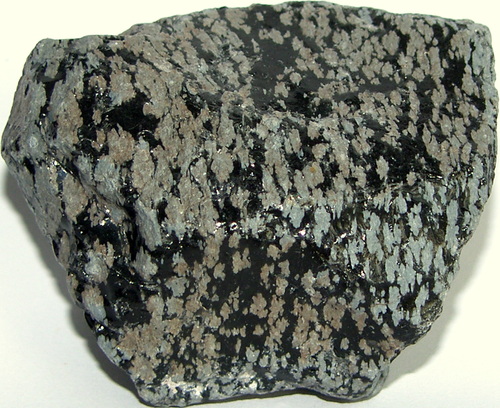Obsidian
A rock classification type
This page kindly sponsored by Gary Umphrey
About Obsidian
Colour:
Black, bluish, mahogany, golden, peacock, grey-green, brown-green etc. - the colors due largely to refraction by microscopic bubbles (and microscopic mineral inclusions such as magnetite in "Rainbow Obsidian").
Lustre:
Vitreous
Glassy, fresh igneous rocks with a high silica content and conchoidal fracture.
The earliest manufactured mirrors were pieces of polished obsidian.
Volcanic glass - a rock rather than a mineral, it is a mixture of cryptocrystalline grains of silica minerals in a glass-like suspension, a super-cooled liquid. Obsidian is formed in the latest stage of volcanic eruptions, the silica left over after most of the other elements and water have been used up are ejected or flow out and rapidly chilled at surface temperatures.
Some varieties resemble tektites and are therefore considered as "pseudotektites".
NOTE on "Transparent/Translucent Obsidian":
A lot of gem-quality water-clear variously coloured 'obsidian' has been offered for sale on the internet (in particular on auction websites) with a variety of sources listed. The material offered for sale is, in fact, an artificial glass mass-produced in places such as Indonesia.
 Visit gemdat.org for gemological information about Obsidian.
Visit gemdat.org for gemological information about Obsidian.
The earliest manufactured mirrors were pieces of polished obsidian.
Volcanic glass - a rock rather than a mineral, it is a mixture of cryptocrystalline grains of silica minerals in a glass-like suspension, a super-cooled liquid. Obsidian is formed in the latest stage of volcanic eruptions, the silica left over after most of the other elements and water have been used up are ejected or flow out and rapidly chilled at surface temperatures.
Some varieties resemble tektites and are therefore considered as "pseudotektites".
NOTE on "Transparent/Translucent Obsidian":
A lot of gem-quality water-clear variously coloured 'obsidian' has been offered for sale on the internet (in particular on auction websites) with a variety of sources listed. The material offered for sale is, in fact, an artificial glass mass-produced in places such as Indonesia.
 Visit gemdat.org for gemological information about Obsidian.
Visit gemdat.org for gemological information about Obsidian.Unique Identifiers
Mindat ID:
8519
Long-form identifier:
mindat:1:1:8519:5
GUID
(UUID V4):
(UUID V4):
c4a7de53-ce4f-47eb-afa0-8731bb0bec31
Classification of Obsidian
Sub-divisions of Obsidian
Mineralogy of Obsidian
Essential minerals - these are minerals that are required within the classification of this rock:
| Glass | A non-crystalline, amorphous, relatively homogeneous solid material with a random liquid-like structure generally ... |
Physical Properties of Obsidian
Vitreous
Transparency:
Translucent
Colour:
Black, bluish, mahogany, golden, peacock, grey-green, brown-green etc. - the colors due largely to refraction by microscopic bubbles (and microscopic mineral inclusions such as magnetite in "Rainbow Obsidian").
Fracture:
Conchoidal
Synonyms of Obsidian
Other Language Names for Obsidian
Varieties of Obsidian
| Cali glass | Rhyolitic volcanic glass from an extended area close to the city of Cali in western Colombia (Ferrière et al., 2021). This glass was originally described by Alexander von Humboldt. Formerly, part of the literature assumed the glass to be a tektite. Mos... |
| Fire Obsidian | An iridescent variety of obsidian. Its 'fire' is caused by thin layers of microcrystals of magnetite (which are approximately the thickness of a wavelength of light) (Ma et al., 2007). The colour of Rainbow Obsidian occurs from a much thicker volume of t... |
| Mahogany Obsidian | |
| Rainbow Obsidian | Obsidian with multicolored iridescence caused by inclusions of hedenbergite nanoparticles (Ma et al., 2001; Nadin, 2007). See also Fire Obsidian. |
| Sheen Obsidian | A variety of obsidian exhibiting a golden sheen effect. |
| Snowflake Obsidian | A rock - a natural volcanic glass containing white 'snowflake' crystal patterns of the mineral cristobalite, originated due to partial crystallisation of the glass. A dark green, man-made material, with inclusions of cristobalite, is known from Danmark. I... |
Common Associates
Associated Minerals Based on Photo Data:
| 84 photos of Obsidian associated with Cristobalite | SiO2 |
| 32 photos of Obsidian associated with Apache Tears | |
| 18 photos of Obsidian associated with Fayalite | Fe2+2SiO4 |
| 7 photos of Obsidian associated with Pyroxene Group | ADSi2O6 |
| 7 photos of Obsidian associated with Hematite | Fe2O3 |
| 6 photos of Obsidian associated with Perlite | |
| 6 photos of Obsidian associated with Snowflake Obsidian | |
| 4 photos of Obsidian associated with Tridymite | SiO2 |
| 4 photos of Obsidian associated with Enstatite-Ferrosilite Series | |
| 4 photos of Obsidian associated with Magnetite | Fe2+Fe3+2O4 |
Internet Links for Obsidian
mindat.org URL:
https://www.mindat.org/min-8519.html
Please feel free to link to this page.
Please feel free to link to this page.
References for Obsidian
Reference List:










Quindío Department, Colombia